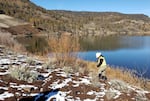
Yurok tribal member and Fish Technician 1 Frank Henry Jr. works alongside Iron Gate Reservoir in Feb. 2023. The reservoir will be drained when Iron Gate Dam is removed as part of the Klamath River restoration.
Juliet Grable / JPR
On the north shore of Iron Gate Reservoir, Frank Henry Jr. jams a heavy metal pole into the ground and twists. Once a hole is excavated, he grabs a stick from a 5-gallon bucket. Water drips from the small tangle of roots at one end. The stick is Klamath plum; it will eventually grow into a shrubby tree that forms dense thickets and produces mauve-colored fruits.
Henry pats native soil — moist, fluffy and sticky with clay — around the plum plant, then moves on to the next one. “I’m digging maybe a 12- to 13-inch hole with the rock bar,” he says. “These little ones that are kind of cluttered together are the ones I’m putting in right now.”
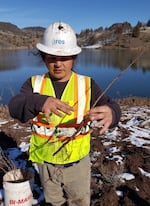
Frank Henry Jr. is a Yurok tribal member and fish technician 1 with Resource Environmental Solutions. He planted Klamath plum on the banks of Iron Gate Reservoir in Feb. 2023 as part of the river restoration program.
Juliet Grable / JPR
It’s February; snow dusts the hills, and aside from the occasional rumble of trucks passing by the reservoir, it’s quiet. The air is cool but the winter sun is warming — not a bad day to work outside.
Henry is part of a crew contracted by Resource Environmental Solutions, or RES, to restore the banks of the Klamath River in the wake of dam removal. Late last year, PacifiCorp transferred ownership of four hydroelectric dams — three in Northern California, one in Southern Oregon — to the Klamath River Renewal Corporation, which is managing the dam removal. Drawdown of the reservoirs is scheduled to begin as early as next January.
Iron Gate is a sinuous, skinny reservoir tucked into the folds of the Siskiyou Mountains. Draining it will expose about 900 acres of wet mud. “It’s our job to make sure it’s revegetated. We want that to be revegetated with a healthy native plant ecosystem,” says Joshua Chenoweth, senior riparian ecologist for the Yurok Tribe who is leading the replanting effort.
Phase 1 is to check the march of exotic invasive plants. For the last two years, Chenoweth’s crew has been mowing a wide ribbon around the shoreline, carefully working around native plants like silver lupine. Last fall, they seeded the strip with a mix of native grasses and flowering plants. Now, they’re installing young shrubs and trees: buckbrush, serviceberry and Oregon ash, along with the Klamath plum. Collectively, these plants will create a “wall of green,” taking up space that would have otherwise been overrun by non-native plants like medusahead, a grass with a sticky seed head that clings readily to hooves and muddy boots.
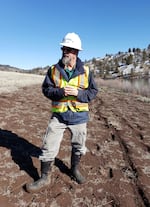
Joshua Chenoweth, senior riparian ecologist for the Yurok Tribe, is leading the replanting effort around Iron Gate Reservoir.
Juliet Grable / JPR
The Klamath plum starts Henry is planting were grown in a nursery in Central Point, Oregon, from wild seed he helped collect in 2020. Henry, who has been part of Chenoweth’s crew since 2019, has also done a fair amount of weed-eating with the “green machine” and wrestled with 30-foot Himalayan blackberry vines, clipping, dragging and piling them for the chipper.
All the technicians except for Chenoweth and one other ecologist are either members of the Yurok Tribe, like Henry, or Karuk, and most have been on the crew for several years.
“Any [revegetation] project, if it’s done right, is adaptively managed by people that understand the landscape. There’s no better place to look for that than the tribes and the people that live here and call it home,” says Chenoweth.
Billions of seeds
The revegetation of the Klamath River has been called the largest river restoration project in American history. Collecting, propagating and growing enough seeds and plants to populate the reservoir footprints — approximately 2,200 acres in all — is a staggering task. RES launched the effort in 2019, recruiting and training crews from area tribes to collect seed and prepare the ground, and partnering with commercial nurseries to propagate plants and seeds.
Their planting design includes 96 different species: culturally significant plants like yampah and lomatium, important pollinator species like milkweed, and tens of thousands of oak trees. In total, RES aims to plant 250,000 trees and shrubs and 40,000 to 60,000 pounds of seed — enough to plant the reservoirs twice.
“We’re up to 13 billion seeds approximately,” says Gwen Santos, regulatory and ecology director for RES. “We’re trying to get to 17 [billion] to 19 billion.”
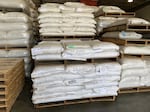
Pallets of native seeds being stored for the Klamath River restoration at BFI Native Seeds in Washington state.
Gwen Santos / Resource Environmental Solutions
There’s no way to collect enough wild seed to meet these targets, so RES has contracted with five commercial nurseries to propagate wild plants specifically for their seed — a process called seed amplification.
“You basically take advantage of nature,” says Santos. “You start with one seed and get a whole plant that produces 10 times the seed you started out with.”
There’s a bit of practical magic involved in transforming a handful of wild seeds into hundreds of pounds, says Matt Benson, manager and farmer at Washington-based BFI Native Seeds, one of the contracted nurseries.
“There’s 6,000 years of agriculture behind every seed I plant when I put in a garden or when a farmer plants a field,” he says. “We don’t have any of that.”

Rows of blue wildrye being grown for the Klamath River restoration at BFI Native Seeds in Washington State.
Matt Benson / Resource Environmental Solutions
The challenges start with getting wild seeds to even sprout. Some must be cold stratified — exposed to a period of freezing — before they will germinate. Once the plants are growing, Benson must figure out how to coax them into producing abundant fertile seed heads.
“A lot of plants are very happy to just make leaves,” says Benson. “When things are great, I can be a big, bushy, green plant and not worry about seed production.” Often, he uses water stress to trigger plants to flower and fruit, which, in the dry Columbia Basin, is easy to manipulate with irrigation water.
BFI, which is located near Moses Lake in Central Washington, has devoted about 40 of their 2,000 acres to the Klamath project. Benson is growing 20 different native species, some of which have yielded surprises. A field of mugwort started out as tiny tufts with gray-green leaves.
“In one year, it shot up almost like corn does,” says Benson. He had to keep raising his sprinklers to accommodate the plants, which eventually towered over 10 feet and produced huge masses of flowers.
Benson appreciates that RES understood the importance of starting early, well before dam removal was actually going to take place. “Three years was just barely enough time,” he says. “Having the right plants at the right time will have a huge impact on the final success of this project.”
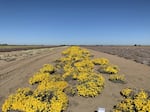
A field of Oregon sunshine being grown for the Klamath River restoration at BFI Native Seeds in Washington State.
Matt Benson / Resource Environmental Solutions
Lessons from the Elwha
What will a restored, wild Klamath River look like? Imagine it. Stand at the Wanaka Springs boat launch and picture Iron Gate Reservoir drained. The river has found its channel at the base of its original canyon. Willows flank the banks. Much of the reservoir footprint is flush with upland vegetation — oak copses, thickets of buckbrush and Klamath plum, blooming rose and lupine.
If your imagination needs a jump-start, Google images of Washington state’s Elwha River circa 2014 and several years hence.
Between 2011 and 2014, two dams were removed from near the mouth of this river, which flows from the Olympic Mountains to the Strait of Juan de Fuca near the U.S.-Canada border. At the time, it was the largest dam removal in the world. The reservoirs were drawn down slowly, exposing a wasteland of mud littered with tree stumps. Within years, thanks to a combination of deliberate planting and natural repopulation, alder and cottonwood trees lined the new riverbank, and lupines, berries, roses and a host of other plants filled in the bare spots.
Chenoweth helped lead the revegetation effort at the Elwha and had settled with his family in Port Angeles, with every intention of watching the landscape evolve. After the Yurok Tribe toured the Elwha site, they began recruiting him for the Klamath River project.
The pull to lead another revegetation effort on an even larger scale proved too hard to resist, says Chenoweth. “Here was a whole new landscape to learn about, and try to apply lessons learned to a new project and advance the science of revegetating reservoirs after a dam removal project.”

Left: Elwha Dam removal work on October 20, 2011. Right: Former Elwha Dam site on May 1, 2012.
National Park Service
Though the Elwha is the obvious analog to the Klamath — both are large dam removal projects in the Pacific Northwest — Chenoweth predicts major differences in how the vegetation responds. For one, the climates are vastly different. In the cool, wet Olympic Peninsula environment, plants in the fine, silty soils took off immediately.
In the warmer, dryer Klamath Basin climate, Chenoweth will take a more aggressive approach, planting and seeding as much as possible as soon as possible so plants can draw from the residual moisture in the soil.
While the Elwha originates in the relatively pristine ecosystem within Olympic National Park, the Klamath flows from a basin highly altered by irrigation and agriculture. The pressure from invasive species is greater here; the composition of native plants surrounding the reservoirs different. At Iron Gate, for example, most of the native upland trees are oaks and junipers. “An acorn is not going to fly 300 feet in the air like a red alder seed in the Elwha,” says Chenoweth. Sticky-seeded exotics like medusahead, on the other hand, will have no trouble finding their way to bare mud.
Chenoweth wants his crews in place, plants and seed in hand, the moment the water levels in the reservoirs begin to recede. For this reason, he is scaling up to 12 to 15 technicians this year. He hopes to recruit from several area tribes, including the Yurok, Karuk, Hoopa and Klamath tribes.
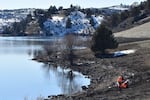
Field technicians with Resource Environmental Solutions doing revegetation work along Iron Gate Reservoir in Feb. 2023.
Juliet Grable / JPR
This pioneer seeding will include a mix of native grasses and forbs that germinate readily and spread rapidly. Later in the year, they will add new species, including wild-collected seed, to create more complexity and diversity.
An important part of their strategy is mimicking how plants naturally grow amongst each other under natural circumstances.
“If plants are in a community rather than a monoculture, they can share resources and outcompete the invasive plants,” says Santos. Planting groups of plants in these “facilitation patches” — a strategy imported from the Elwha project — will also help accelerate their growth.
Despite the monumental effort, nature will still do most of the work. Following two years of active planting, RES will maintain and monitor the sites for five years, adapting their strategy as needed.
“We’re trying to introduce as great a diversity as possible, then let the landscape teach us what’s going to grow and work well,” says Chenoweth.

